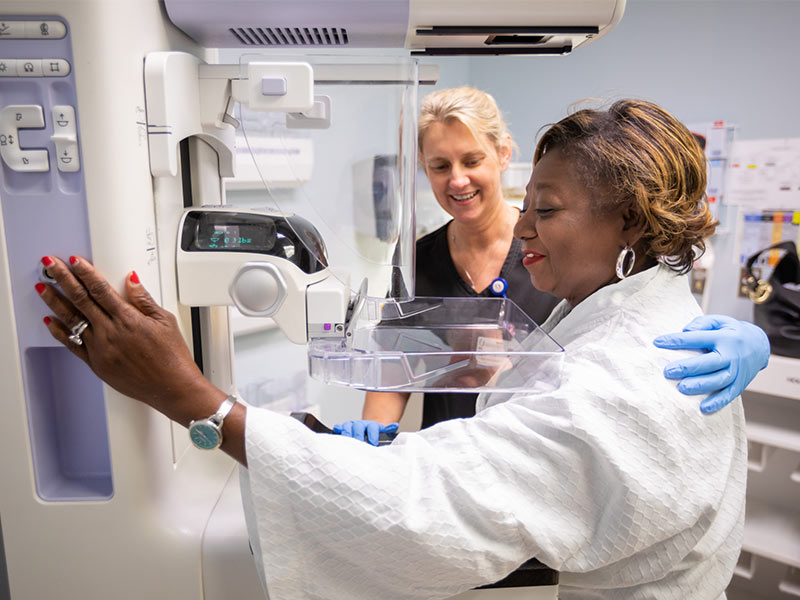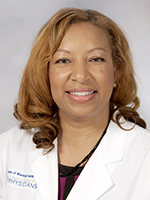Breast cancer screenings can save lives

Getting screened for breast cancer by University of Mississippi Medical Center caregivers, Cindy Ayers-Elliott says, could have saved her life.
Ayers-Elliott, a Jackson resident and full-time farmer, hadn’t gone in for a mammogram in two years. She took advantage of the See, Test and Treat program, a part of the College of American Pathologists Foundation, offered annually at UMMC’s Cancer Center and Research Institute at the Jackson Medical Mall.
The free breast and cervical cancer screens especially target uninsured and underinsured women. Ayers-Elliott, a former investment banker, got unsettling news after her mammogram.

“There was a little mass showing,” she said. “I had to do another screening. UMMC made it all so seamless and easy, and they reached back to my last mammogram at a different place and got my records. They were able to compare the scans to make a better decision on what to do.”
The second scan confirmed the mass was fatty tissue, not cancer, but it strengthened Ayers Elliott’s resolve never to miss another annual mammogram. “Every woman should have the opportunity to have peace of mind about her body,” Ayers-Elliott said. “To have this done made a big difference in my peace of mind.”
Her message drives home the purpose of Breast Cancer Awareness Month. Observed every October and organized by major breast cancer charities nationwide, it strives to raise awareness about the importance of finding breast cancer early through screenings such as a mammogram.
Dr. Shawn McKinney, associate professor of surgery and a fellowship-trained breast surgeon, said breast cancer screenings can detect cancer in its earliest, most treatable stage.

“It is important for women to get regular yearly screening mammography in order for the radiologist to compare the images and potentially pick up subtle changes before symptoms arise such as a palpable mass,” McKinney said. “If an early-stage breast cancer is found, the patient has the potential to avoid more aggressive surgery and/or chemotherapy. The later, and larger the abnormality, the greater the likelihood that more aggressive therapy will be needed.”
A mammogram is an X-ray of the breast that detects breast changes. In a process that should take no more than 20 minutes, the breast is compressed between two plastic plates for a few seconds while an X-ray is taken. It’s repositioned and compressed again several times to take different views.
Flattening the breast is uncomfortable, but it’s needed to provide a clearer view. If a doctor finds something suspicious, he or she will usually have the patient return for new X-rays or other tests. Suspicious readings could mean dense or fatty breast tissue, a cyst, an abscess or a tumor, which could be benign or cancerous.
The Medical Center also offers three-dimensional mammograms, capturing multiple slices of the breast at different angles, then bringing them together to create crystal-clear images that reconstruct the patient’s breast.
Breast cancer develops from cells in the breast, with the most common sign a new lump or mass. Other signs include swelling of part of a breast, even if no lump is present; skin irritation or dimpling; nipple pain or retraction; redness or scaly appearance of the nipple or breast skin; or a discharge other than breast milk.
Most lumps or masses are benign, but the earlier breast cancer is found, the better the chances for successful treatment. A mammogram can often show breast changes that could be cancer before physical symptoms develop.
The American Cancer Society estimates that this year, there will be 268,600 new cases of breast cancer in women and 2,670 in men. Deaths caused by breast cancer this year are estimated at 41,760 for women and 500 for men.
And, the society says, the five-year relative survival rate for a breast cancer that hasn’t yet spread is 99 percent, and for that same time period for all breast cancer stages combined, 92 percent for white women and 83 percent for African-American women.
Those most at risk of invasive breast cancers are women age 50 or older, but being a woman is the main risk factor. Breast cancer risk also is higher among women with a family history. It’s important to remember, though, that most women with breast cancer don’t have a close relative who had the disease.
The Medical Center follows the guidelines of the National Comprehensive Cancer Network, which recommends that women of average risk for breast cancer get a breast exam every year beginning at age 25, and an annual screening beginning at age 40. The NCCN also says women should consider three-dimensional mammography for their annual screening.
In some cases, the NCCN recommends more frequent or earlier mammograms for women at increased risk because of personal or family breast cancer history.


